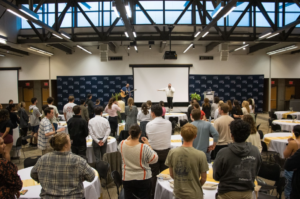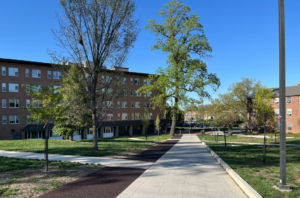Mullen Library Hosts Art Exhibit
By Caroline Firrioli
Contemporary artist Kay Jackson visited the Catholic University of America’s Mullen Library on Wednesday, January 25 to share a collection her art. Her artwork filled the May Gallery, where the collection will live for the coming months, and also part of the hallway. Throughout this opening reception, numerous professors and students walked around to admire her work.
Washington, DC based Kay Jackson creates her artwork by using medieval tools that are becoming more and more scarce and uses these endangered art tools to create artwork that resembles endangered animals. Through her art pieces, she calls to attention many different topics such as environmental issues, nature, overpopulation, endangered animals, and various other themes. Through her paintings and sculptures she shows the various vanishing things of this Earth, not just animals, but also the tools she uses to create such art.
Kay Jackson has been creating various types of artwork for more than 30 years. Her artwork has been exhibited nationally as well as internationally. She has been exhibiting her work since 1982 and has held solo exhibitions since 1985. Her work has been displayed in places such as Georgetown University’s Fine Arts Gallery in Washington, DC, Vaughn-Goodman Gallery in Jackson, Mississippi, and The Working People’s Cultural Palace in Beijing, China. One of her most well known art pieces was her nocturne painting of the White House which was used on President and Mrs. Clinton’s holiday card in 1997.
“I liked the seahorse piece,” said Jamie Marandola, a freshman exploratory major. “I thought it was beautiful and admirable that she used old techniques to create modern pieces and draw attention to endangered species.”
Jackson uses various types of techniques and tools to create meaningful creations. She uses ancient gliding techniques and creates multidimensional artwork to show the fragileness of the environment and wildlife. She also uses old glazing methods in her artwork and through these techniques she explores various platforms to use and incorporate such themes into her projects.
“I think that her artwork is a very interesting and creative way of keeping tradition and culture alive. Her artwork is thought provoking and is very powerful,” Marandola said.
Jackson’s most notable attribute of her artwork is her incorporation of gold leaf techniques. The art of gilding is a rarely used craft that is nearly extinct. Her incorporation of such a technique helps draw in the parallels of her tools and also her themes. The gold leaf techniques she incorporates into her pieces can also been seen in paintings from the 13th and 14th centuries. Her contemporary usage of this vanishing artistry sets her artwork apart from that of others.
“I liked how different and clear her artwork was,” said freshman Elizabeth Rich, a double-major in theology and finance. “With other contemporary artwork, you wrack your brain to try and figure out what it means but with this artwork you don’t have to guess. You know what it’s saying to you and you can understand it and really think about it.”
On Jackson’s website, she quotes herself by saying, “Every painting is a survey of an artist’s work, a summation of all previous paintings and a rehearsal for future endeavors.”
“I loved how she was using her talents to make a change in the world. She actually acted on her passion instead of being angry with the world,” said Rich.
Jackson’s artwork is available to be seen at The Smithsonian American Art Museum in Washington, DC and also in the Corcoran Gallery of Art in Washington, DC.








